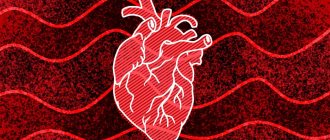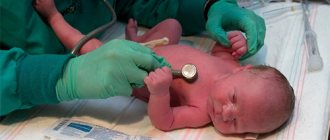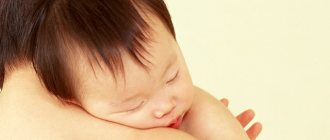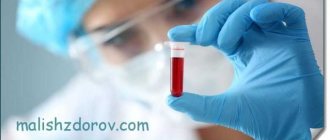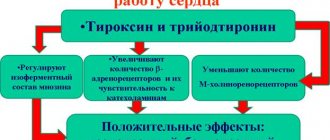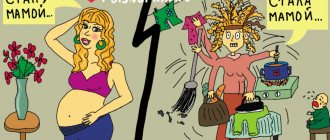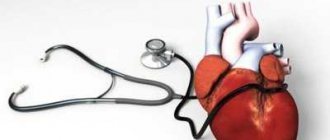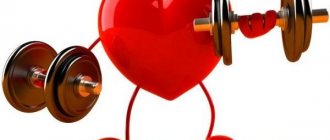5 / 5 ( 3 voices)
Unidirectional blood flow in the chambers of the heart is ensured by valves located between them. When the atria contract, the valve leaflets open, and when the ventricles contract, they close, becoming like a parachute filled with air.
The chordae of the heart are like “parachute lines” stretched between the edges of the valve and the papillary ventricular muscles. An extra chord in the heart is an anomaly in the development of the number of such jumper threads.
Arrows show the direction of blood flow in the heart
An excess of chordal filaments-bridges is an anomaly of intrauterine development, which can be inherited, result from a gene mutation or adverse effects (bad habits of the mother, infectious diseases) on the fetus. Their number above the norm is variable.
Moreover, they can be located in the same way as the rest of the chordal cords - longitudinally the axis of the heart. In this case, and with normal thickness, additional chordal formations do not interfere with the work of the myocardium.
What is a chord in the heart?
The heart muscle normally consists of the following parts:
- right ventricle;
- left ventricle;
- left atrium;
- right atrium;
The organ also contains auxiliary valves that help pump blood. Normal blood circulation through the vessels of the body at a sufficient speed is ensured by rhythmic contractions of the heart muscle. The valves are movable and perform the function of letting blood in and out of the heart.
The chordae perform an important protective function of the heart valves from sagging over time. They are strong tendon threads that are attached to the leaflets of the atrioventricular valves. The chords ensure the normal operation of the movable valves by holding them. During normal development, one chord should be attached to each valve leaflet.
Also read a similar article about the window to the heart.
What are the chords in the heart?
Chords in the heart are divided into 3 types:
- Natural - those that are laid down by nature to ensure normal functioning of the heart. They help the valves contract and move blood around the body. They also have the function of protecting against valve sagging with age.
- Abnormal - additional chords, which are divided into some subtypes and create some obstacles to the normal functioning of the cardiac organ.
- False chord in the heart - when listening to the heart, murmurs may be detected that are mistakenly taken by the doctor for chords, however, upon further diagnosis they are not detected, and the murmurs appear as a consequence of another cause.
An abnormal chord in the heart can be divided into the following subtypes:
- right ventricular chords – about 5% of cases;
- left ventricular chords – about 95% of cases;
- single – 70%;
- multiple – 30%;
- diagonal;
- longitudinal;
- transverse;
- apical;
- middle;
- basal;
Correctly determining the type of additional chord is of great importance for the patient, since different types of chords can bring different inconveniences in human life.
In the course of their research, experts divided the existing chords into 2 categories:
- Potentially dangerous;
- Safe;
Patients whose pathologies belong to type 1 chords should be under the supervision of a doctor and undergo periodic examinations.
For example, single longitudinal chords in the ventricles of the heart do not create obstacles to the normal functioning of the cardiac organ, but if the chord is located transversely, it can significantly impede the normal outflow of blood.
Multiple chordae are often hereditary diseases and can further provoke the development of certain heart diseases:
- arrhythmias;
- intraventricular conduction disorders;
- ischemic stroke;
- in rare cases can provoke a heart attack;
Multiple chordae should be under the supervision of a cardiologist in order to begin treatment of the pathology in a timely manner, if necessary.
Forecast
With additional chords you can serve in the army and have children. The pathology does not affect the ability to bear a fetus and allows girls to count on a favorable outcome of natural childbirth.
If the chord is not resolved before puberty, it persists for life. The anomaly has virtually no effect on the duration and quality of life. Serious complications are diagnosed in only 1% of children.
There is no need to worry about the presence of an anomaly. It is important to remember that a person is absolutely complete, he just sometimes needs attention from specialists. Periodic examination ensures the absence of any negative reactions. Virtually no treatment is required.
Additional chord in the heart - what is it?
An additional chord in the child’s heart is formed during pregnancy, when the heart muscle is formed. They are often isolated and do not cause discomfort. It is not a serious pathology that requires medical intervention, however, after detection, periodic monitoring by a specialist is required.
The additional chord has the following characteristics:
- It has no effect on hemodynamics - such chords are benign formations in the heart muscle that do not affect its normal activity in any way and do not require treatment.
- Affects hemodynamics - in this case, the chord affects cardiac activity in one way or another, especially for transverse chords, and requires periodic monitoring by a specialist with the possible prescription of treatment.
An abnormal formation inside the heart cannot always be detected; there are cases when people live for years without suspecting anything.
Is this pathology dangerous?
When a child is diagnosed with an additional chord of the heart, then, as a rule, parents begin to panic and take him to all possible doctors. There is no need to do this, as this is not a disease. But there are different types of this anomaly.
For minor ones, doctors recommend simply establishing a correct and regular daily routine for the child, a healthy balanced diet, etc., but for significant anomalies, one should be under the supervision of a cardiologist, and sometimes you need to take medications.
If a child has only one false chord of the heart, then cardiologists do not consider this a pathology, but rather a normal deviation. The chord in the area of the right ventricle is examined more carefully.
A false chord in the heart can pass without a trace for the child, or may develop into a cardiovascular disease in the future. Typically, the first signs begin to appear during adolescence. Heart rhythm disturbances and aching pain may occur.
Already an adult with such an anomaly is susceptible to tachycardia, arrhythmia, etc. It should be remembered that this does not occur in everyone. Even if this pathology does not cause any discomfort to the child, he should be regularly examined by a cardiologist.
Causes of the anomaly
There are several possible reasons when a child develops a chord of the left ventricle of the heart during intrauterine development.
These include:
- hereditary factor , when one of the child’s parents also has extra stringy formations inside the heart, most often transmitted through the maternal line;
- Improper lifestyle of the mother - the use of drugs, alcoholic beverages or smoking tobacco products can negatively affect the development of the fetus. Especially if these factors took place at 5-6 weeks of pregnancy, when the baby’s heart muscle is actively forming;
- unhealthy diet with excessive amounts of animal fats;
- heavy physical activity on the pregnant body;
- intrauterine infections in the fetus;
- reduced maternal immunity in the first trimester of pregnancy;
- living in a contaminated region (chemical and heavy industry waste, increased background radiation);
- frequent stressful situations that have an impact on the nervous system and psyche;
In order to bear and give birth to a healthy child without developmental pathologies, it is necessary to protect yourself in every possible way from the influence of negative factors that may have an impact on the formation of the child.
Symptoms and diagnosis
In early childhood, a chord in the heart may not manifest itself in any way and may be discovered completely by accident, during the examination of another disease. This rule also applies to single chords, which are located in the left ventricle.
If there are multiple or transverse abnormalities in the right ventricle, you may notice the following symptoms in the child:
- cardiopalmus;
- frequent and rapid fatigue;
- feeling of weakness in the body;
- the appearance of frequent dizziness;
- discomfort and tingling in the heart area;
- frequent mood changes;
- heart rhythm disturbance.
In the presence of formations in the right ventricle, these manifestations cannot always be noticed in early childhood. Most often they appear during the period of active growth of the child - in primary and secondary school age.
If you suspect the presence of a chord, you should contact a pediatrician who will conduct research and, if necessary, refer you to a cardiologist.
To diagnose the disease, the following measures are taken:
- The doctor asks the child in detail about the
manifestations of pathology and general well-being; - using a stethoscope, the heart rhythm is listened to; if there is a chord, extraneous noise will be heard;
- Ultrasound examination of the heart muscle allows you to examine the pathology on the monitor, find out its location and determine the category (dangerous and non-dangerous);
- an electrocardiogram is prescribed to determine the heart rate in order to exclude pathology;
- daily recording of an electrocardiogram to determine the average indicator in different states of the child’s activity;
- If necessary, bicycle ergometry is performed - measuring cardiac activity during physical activity.
Today, all children at the age of 1 month have electrocardiogram readings taken to diagnose possible heart diseases for the purpose of prevention and timely treatment of pathologies.
Symptoms of the pathological phenomenon
You can suspect the presence of an abnormal chord in the heart only if some external signs begin to appear. In other cases, the abnormal structure is determined not only in a child, but also in an adult during an ultrasound examination.
If the child began to complain about the rapid onset of fatigue, the parents began to notice that the child’s level of endurance had decreased excessively, it is important not to speculate theoretically about what caused such changes, but to go to the hospital for medical help.
Adult patients often complain of pain in the heart area. They also experience headaches and a rapid heartbeat. If such symptoms occur, it is recommended to consult a cardiologist.
Manifestations of an additional chord in the heart and what disorders does it lead to?
An additional chord in the heart may not manifest itself in any way, or it may lead to the symptoms described above - this depends on their number and specific location. It is important for parents not to ignore the child’s complaints about fatigue and poor health, but to conduct a thorough diagnosis from a specialist.
The consequences of the presence of a tumor in the heart muscle can be as follows:
- sometimes, as the organ grows, the chord may shift or decrease in size, becoming inaccessible for its diagnosis. In this case, it cannot in any way interfere with the normal functioning of the child;
- the appearance of a violation of the blood conduction of the muscle;
- arrhythmia;
- endocarditis;
- thrombophlebitis;
- in severe cases, ischemic stroke;
- rapid fatigue even with moderate physical activity;
- severe dizziness, sometimes fainting;
- heart rhythm disturbances;
- frequent mood swings;
It often happens that “dangerous” types of formations can lead to general underdevelopment of connective tissue, which, in turn, threatens the following pathologies:
- high growth;
- thin build;
- joint hypermobility;
- deformation of bone tissue;
- diseases of the gastrointestinal tract;
- diseases of the kidneys and excretory system;
It is impossible to say for sure whether a chord in the heart is dangerous - you need to carefully analyze the situation, symptoms and type of neoplasm.
Treatment of the consequences of an additional chord
Often, if an additional chord is detected, no treatment is prescribed, however, in severe cases of pathologies with manifestations in the form of discomfort and pain in the heart area, the doctor may prescribe the following drugs:
- fortified complexes enriched with B vitamins;
- preparations containing magnesium and potassium;
- antioxidants;
- nootropic drugs.
It should be remembered that medications are prescribed only by a specialist after diagnostic measures have been carried out.
In particularly severe cases, when multiple chordae interfere with the normal functioning of the heart muscle, surgery may be prescribed, however, this happens extremely rarely.
Recommendations for anomalies - lifestyle, what not to do?
To maintain the normal functioning of a person with abnormalities in the development of the heart muscle, it is necessary to observe the following lifestyle:
- harden from childhood
, this is useful not only for strengthening the cardiovascular system, but also for the prevention of acute respiratory diseases, strengthening the overall endurance of the body;
organism - maintain proper nutrition high in vitamins, microelements and other beneficial contents. Reduce the amount of fatty, salty and spicy foods you consume;
- establish a daily routine - devote enough time to sleep (at least 8 hours a day, for children to take naps during the day), replace work with rest, alternate mental and physical work;
- start the day with morning exercises or engage in vigorous physical exercise throughout the day;
- take regular walks in the fresh air;
- completely give up bad habits - smoking and drinking alcoholic beverages;
- if possible, eliminate or reduce the number of stressful situations that affect a person’s psychological state;
- regularly take courses in relaxing therapeutic massage;
- engage in the prevention of infectious diseases;
With a mild degree of pathology, you can lead a normal life without denying yourself active hobbies and sports. However, an additional chord and an army are incompatible concepts, since they involve great physical activity, which is contraindicated for this pathology.
Experts classify the formation of an additional chord in the heart as a minor pathology, which in most cases does not require drug treatment or surgical intervention. In general, the forecast is quite positive. However, it is still necessary to monitor the development of the disease, sometimes visiting doctors and performing control diagnostic measures.
Possible methods of treatment and prevention
The study of this disease in a patient is carried out through a comprehensive examination, which allows us to identify the presence of the disease and its complexity:
- Examination by a cardiologist. This is where the examination process itself begins. During the listening process, the doctor will definitely hear a heart murmur and, based on this, will prescribe additional examinations.
- Ultrasound of the heart.
- Cardiogram (simple and with load).
- Daily monitoring.
- Load tests.
A detailed study of the studies conducted will help the doctor draw a conclusion about the type of chord, its quantity and the danger that it does or does not pose to the human body. Most often, doctors assure parents that this disease occurs very often among children and it does not pose a danger to the child’s future life. They put the child under control, making a note that the noise heard refers to the presence of a chord in the heart.
Despite the fact that a chord in the heart is an absolutely harmless disease, the presence of many chords can lead to disturbances in heart rhythm, which will result in difficulties in enduring physical exercises and stress.
- Such a child will have to limit physical exercise. For example, you will have to give up gymnasts, dance classes or physical education.
- Young men with this diagnosis are not drafted into the army.
- The presence of an additional chord can become a reason for restrictions in swimming (being under water is specifically contraindicated), and parachute jumping can become dangerous. And professional sports are out of the question.
- People with excess chordae need to learn to rationally distribute all physical activity throughout the day, evenly alternating it with rest.
- In addition, physical exercise for therapeutic purposes has a good effect. Drill exercises, exercises on benches, a Swedish wall, and exercises using a skipping rope, balls or hoops turn out positively. Jumping, running, climbing and dance steps are also effective exercise therapy.
- For such people, it is very important to monitor a balanced diet.
- It is important to take care of normalizing your daily routine.
- If you have this disease, you need to take care of the nervous system, maintaining its functioning in a stable state.
- Children with an extra chord are contraindicated from suffering from chronic diseases. It is important to try to avoid diseases that can weaken the body and provoke various complications.
An abnormal chord in the heart cannot be cured with simple medications. But we should never forget about health. On the contrary, the patient must remember the risk stage, do not forget about prevention, taking care of maintaining a daily routine, and adhering to a proper balanced diet.
And even though most experts do not consider the presence of an additional chord to be any deviation, we still cannot forget about its presence, because any heart disease carries a negative risk factor for human health and life.
In cases where the patient experiences discomfort and exhibits the above symptoms of the presence of a chord, doctors prescribe medication.
- To provide additional nutrition to the heart muscle, groups of vitamins are used. Vitamins are selected and prescribed by a doctor. Their application is carried out in a course.
- To normalize the repolarization processes, drugs with a high content of potassium and magnesium are used, which are also used in a certain course in accordance with the prescribed regimen of the doctor.
- To improve metabolic processes in cells, antioxidants are used.
Despite the fact that vitamins are the main drugs prescribed, their use without the knowledge of a doctor is strictly contraindicated. The doctor selects medications in accordance with individual indicators, medical history, symptoms and many other factors. In any case, doctors advise their patients not to focus on the disease, but to lead a normal lifestyle without overstraining the body.
It is important to find a middle ground that will allow you to lead an active lifestyle without unnecessary restrictions.
